
Skid Steer: The Ultimate Guide
Updated:
Table of contents
- What Is a Skid Steer?
- A Brief Overview of a Skid Steer
- Key Features
- When was the skid steer invented?
- What can you use a skid steer for?
- Radial Lift VS Vertical Lift
- Wheels VS Tracks
- Skid Steer brands
- Skid Steer Attachments
- What attachments can I get?
- Skid Steer Prices
- What about buying a used skid steer?
- Additional Costs
- Things to consider when buying a skid steer
- Conclusion
- Maple Lane Skid Steers
What Is a Skid Steer?
A Skid Steer, sometimes called a skid loader or compact track loader, is a compact machine that uses both mechanical and hydraulic functions to accomplish a variety of tasks. They are well loved in construction, agriculture, and landscaping.
Many of the jobs that a skid steer performs would otherwise be done by hand, so it is understandable that they are so popular.
In this article, I want to lay out everything there is to know about these useful little machines. We will look at the history of them, innovations that have been made, uses, brands, prices, and the benefits of renting compared to buying.
My hope is that after reading this article, your questions about skid steers will be answered.
A brief Overview of a Skid Steer
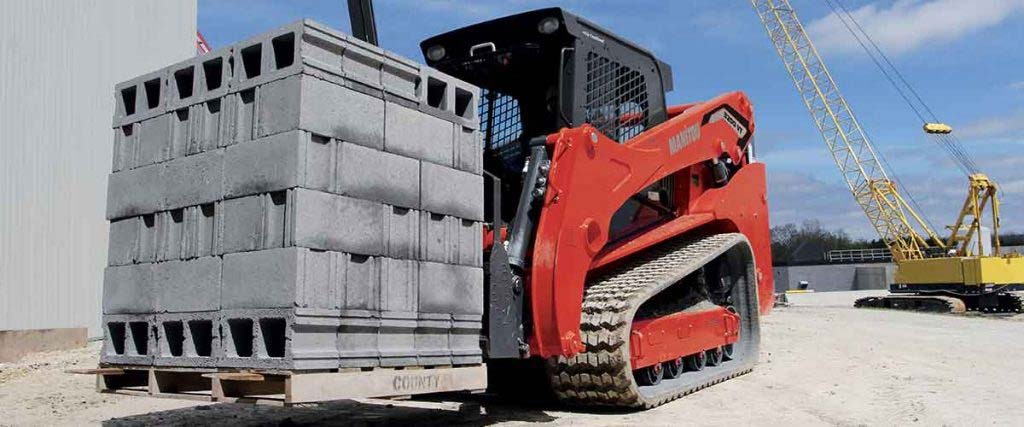
A skid steer is a versatile and compact machine used in construction, farming, and landscaping. It is widely used in these industries because of its ability to adapt to various jobs.
Skid steers use attachments to accomplish different tasks. These attachments enable it to do all sorts of things, such as dig, lift, drill, pound, and more. (We will discuss this in depth in the Attachments portion of the article)
The main characteristic of a skid steer is its ability to pivot, or “skid”, in a spot barely larger than the machine’s footprint. This makes it ideal for tight workspaces and heavy jobs that might otherwise be done by hand.
Generally, operators use joysticks to control the machine operations, but some also incorporate foot pedals for some controls.
Key Features
Some of the largest benefits skid steers can offer you are:
Compact Size
Skid steers come in a variety of sizes, but are comparably small machines for the amount of work they can accomplish. Their footprint is extremely small, but they are also compact on all sides, allowing them to get into tight spaces. They also do not require much headroom.
They are lightweight compared to other equipment, and have excellent weight distribution, which allows them to travel over worse ground conditions.
Tracks or 4-wheeled Options
Skid steers can be equipped with wheels, or tracks. This makes them even more versatile, as tracks enable the machine to travel in the worst of conditions.
Independent Steering Controls
Skid steers have independent steering, meaning the right and left sides are independent of each other. It is because of this that they have such a small turning radius.
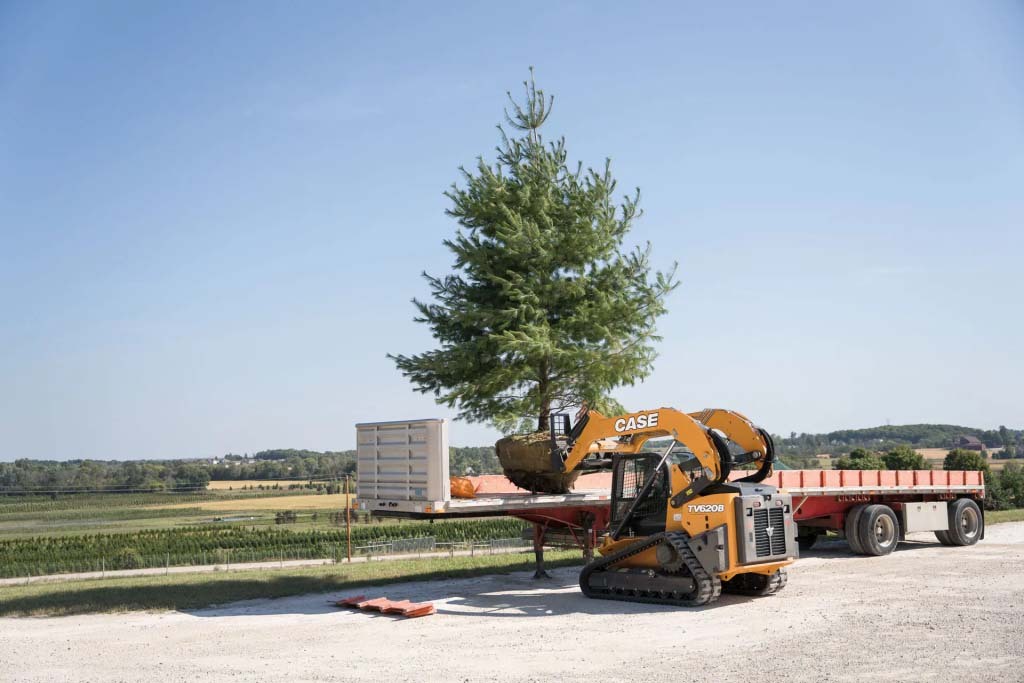
Attachments
This is something we are going to discuss A LOT in this article, but attachments are an absolute necessity for skid steers.
It’s a useful machine with only a bucket or pallet forks, but did you know you can mix cement, use a backhoe, or drill a hole? These can be easily swapped with each other. Attachments make your skid steer a multipurpose machine that can tackle nearly any job.
Lift Capacity
This is one of the most important metrics for skid steers. Lift capacity determines the type of work you can accomplish. Lift capacity is calculated by a series of tests. The machine will be loaded with weight until it begins to tip. Once they determine that weight, they cut it in half, and that is the skid steer’s rated operating capacity. Any weight beyond this measurement can prove dangerous to an operator.
This must be done at multiple heights and angles to ensure all factors are accounted for. Different size categories have a variety of lifting capacities, so it is important to know what you will be using it for before purchasing one.
Versatility
Skid steers can perform the jobs of multiple machines, and can do so across multiple industries.
Safety
Skid steers are equipped with a number of safety features. Because of the dangerous conditions they work in, they need to offer protective solutions to the operator. One of these is the ROPS, or Roll-over Protective Structure around the cab, which keeps the operator safe if there is a rollover or large falling debris.
When was the skid steer invented?
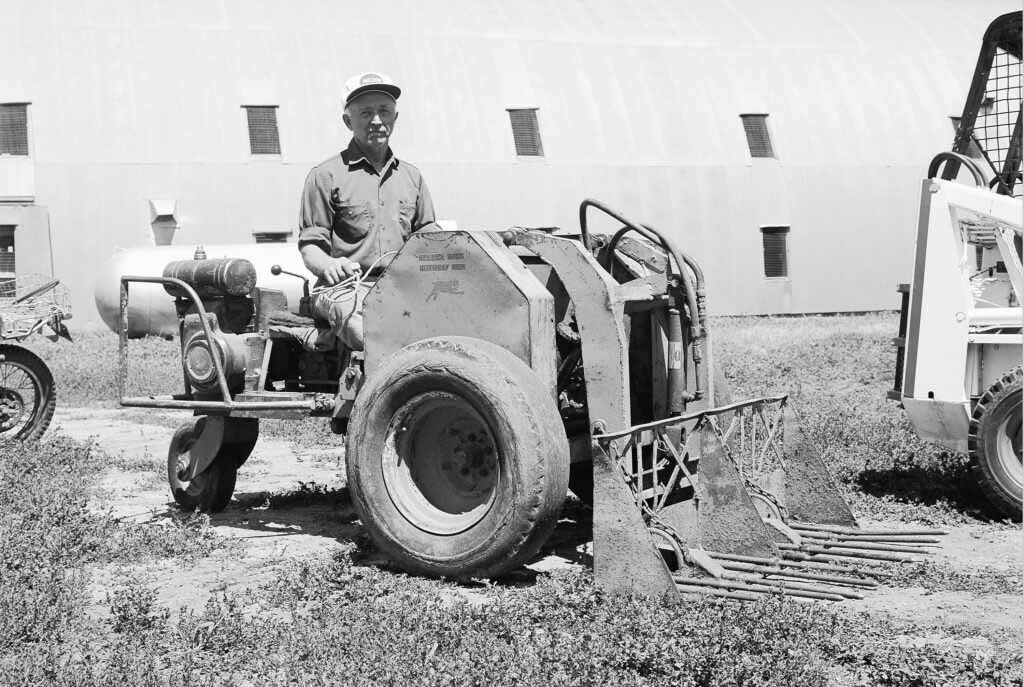
The skid steer was originally the result of a couple guys who wanted to help their friend out. Louis and Cyril Keller were trying to help a friend of theirs remove manure from his barn. The initial design was a machine with two independent front wheels and a caster on the back, allowing it to turn within its own footprint.
That was 1957.
Within a year, their design was purchased by the Melroe Manufacturing company, which then hired the Keller brothers to continue their design innovation.
Melroe launched the “Melroe Self-Propelled Loader” in 1958, which still had the rear caster wheel. The rear wheel was replaced with an axle in 1960, and the result was the worlds first true skid steer.
Melroe adopted the name “Bobcat” for the machine because of its compact size and agility.
By the end of the 1960’s, many companies had similar designs on the market, and since then they have become a staple on farms and construction sites.
What can you use a skid steer for?
As was already mentioned, skid steers have a wide variety of uses. Of course, the list could be endless, but here are a few industries that rely heavily on them.
Construction
Likely their most popular application, skid steers have been used in construction for decades. They can be useful in almost any phase of a build.
- Excavation- certain attachments can dig trenches using augers, excavate foundations, or can be used to grade land.
- Material Handling- considering the amount of material that needs to be moved around a construction site, skid steers play a crucial role in moving pallets of stone, lumber, and drywall around a work site.
- Demolition- They can be equipped with jackhammers to remove concrete, push down walls, and remove debris.
Landscaping

Skid loaders are also widely used in landscaping. They are extremely useful by moving mulch and sod, and they can do light excavation that is so often done in landscaping.
Farming

Farmers use skid steers for feeding, moving and stacking hay, and cleaning out, which is what they were originally invented for.
Forestry
There are brush cutters and mulching attachments for skid steers that make them especially useful for foresters.
Mining

Mining operations use skid steers to handle materials, and to transport equipment.
Infrastructure
Skid steers are often employed for utilities work, such as road maintenance and repair.
Waste Management
In extremely dirty environments, such as waste management facilities, skid steers are a great alternative to moving debris by hand or with shovels. They can also do the work considerably faster.
Property Maintenance

You can use a skid steer to cut brush, mow, dig fence post holes, and even install posts with a post-pounding attachment.
Sale Yards
Stores with large products and outdoor storage often use skid steers to move pallets of goods.
Snow Removal

Skid steers equipped with snow blowers, plows, or brooms are used for clearing snow from roads, sidewalks, and parking lots.
There are many other applications, but you get the idea.
Radial Lift VS Vertical Lift
While they tend to be very similar, there are two distinguishing features that make skid steers differ. The first is the lifting mechanism. The two types of lifting mechanisms are radial lift and vertical lift.
Radial lift and vertical lift are two different types of lift mechanisms used on loaders, and they have distinct characteristics and applications. The primary difference between them lies in how they raise and extend the machine’s lift arms and bucket or attachment. Here’s a breakdown of the differences between radial lift and vertical lift:

Radial Lift
- Lift Path: Radial lift skid steers have a radial lift path. This means that the lift arms follow a curved or “radial” trajectory when raised. As the arms are raised, they arc outward before reaching their maximum height.
- Vertical Height: Radial lift generally have a lower maximum vertical lift height compared to vertical lift. This makes them suitable for tasks where you need to lift and dump materials into containers or trucks with lower sides.
- Application: Radial lift skid steers are well-suited for tasks that require reaching forward or over obstacles, as their lift path allows for extended reach. Common applications include digging, grading, and material handling.
- Visibility: Radial lift machines typically offer better visibility to the operator when the lift arms are in the raised position because the arms move forward and away from the operator’s line of sight.
- Stability: Radial lift skid steers are known for their stability during digging and lifting tasks, making them ideal for applications where stability is essential.
Vertical Lift
- Lift Path: Vertical lift skid steers have a vertical lift path, meaning that the lift arms follow a straight up-and-down trajectory as they are raised.
- Vertical Height: Vertical lift can achieve a higher maximum vertical lift height compared to radial lift. This makes them suitable for tasks that require lifting materials to greater heights, such as loading materials onto high-sided trucks or placing items on elevated surfaces.
- Application: Vertical lift skid steers are often preferred for tasks involving pallet handling, loading materials onto elevated platforms, and tasks where vertical reach is essential.
- Stability: While vertical lift skid steers are stable machines, they may have slightly different stability characteristics than radial lift machines during certain types of lifting and loading tasks.
Radial lift machines are better for tasks that require extended reach and good visibility to the front, while vertical lift machines excel at lifting materials to greater heights.
Wheels VS Tracks
The other distinguishing feature of skid steers is whether they have wheels, or tracks. Each one serves a different purpose.
Wheels
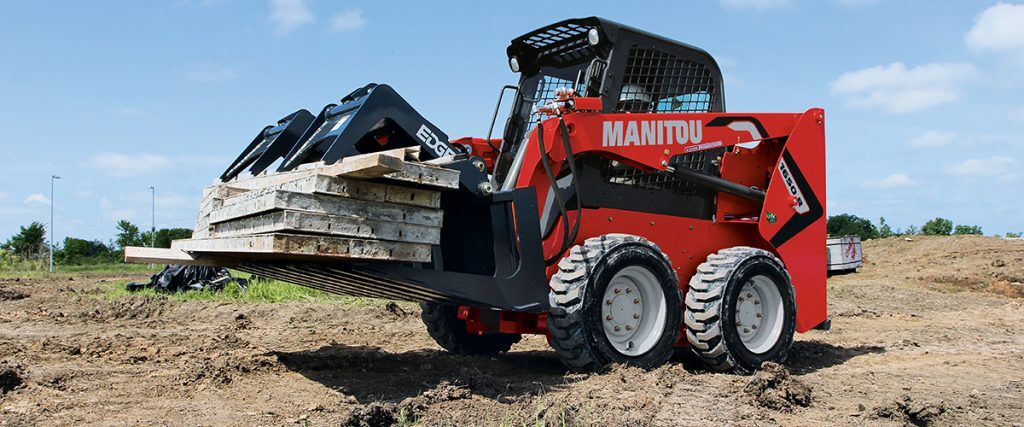
- Maneuverability: Wheeled skid steers are highly maneuverable and excel in tasks that require frequent changes in direction or tight turns. They have a small turning radius, making them ideal for working in confined spaces and urban environments.
- Speed: Wheeled skid steers are generally faster than their tracked counterparts, which can be advantageous when moving around large job sites or traveling between locations.
- Surface Compatibility: Wheeled skid steers are best suited for hard, stable surfaces such as asphalt, concrete, and gravel. They are less effective on soft or muddy terrain, where they can get stuck or leave deep tracks.
- Maintenance: Maintenance for wheeled skid steers is often simpler and less expensive than tracked models. Tire replacement is a common maintenance task.
- Cost: Wheeled skid steers are typically less expensive to purchase initially than track loaders, which can make them a cost-effective choice for certain applications.
Tracks
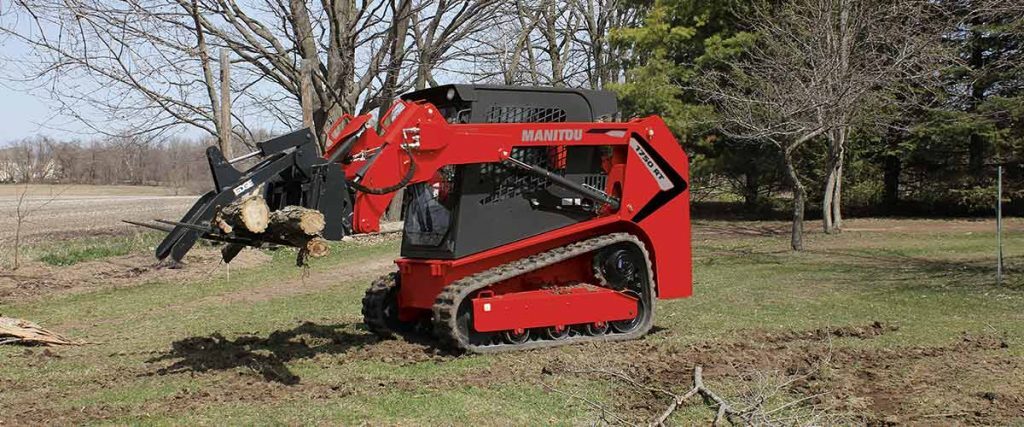
- Traction: Track loaders offer superior traction, especially on uneven, muddy, or soft terrain. The tracks distribute the machine’s weight over a larger surface area, reducing ground pressure and minimizing surface damage.
- Stability: Track loaders are often more stable on rough terrain and when lifting heavy loads. They are less prone to tipping over, which can be a safety advantage.
- Floatation: Tracks provide better floatation on soft surfaces like mud, sand, or snow, making track loaders suitable for a wider range of weather conditions and environments.
- Weight Distribution: The weight distribution on track loaders is more evenly spread, which can reduce soil compaction and minimize damage to delicate surfaces.
- Less Surface Damage: Track loaders tend to cause less surface damage on sensitive terrain, making them preferable for landscaping, forestry, and environmental restoration projects.
- Versatility: Track loaders are versatile and can be used in various applications, including forestry, construction, and agriculture, where soft or uneven terrain is common.
Once you determine what you will use your skid steer for, it is easier to know what to purchase.
Skid Steer brands
There are many brands that produce high quality skid steers. Since the 1960’s, many companies have joined the light equipment industry.
Because these machines are so useful in so many different ways, the market is very competitive. This is actually useful for customers, since the competition drives companies to innovate and improve their products and prices.
Obviously no one wants to buy from a company that offers a sub-par product, so we will only focus on top manufacturers. (This list is not meant to represent the order of best to worst in the skid steer market, but simply display some outstanding companies)
Bobcat

Bobcat was the original company to build skid steers. They were formerly the Melroe Manufacturing Company that purchased the rights to the Keller Loader. Since those early inventions, they have developed a successful brand of light construction equipment and utility vehicles.
Caterpillar
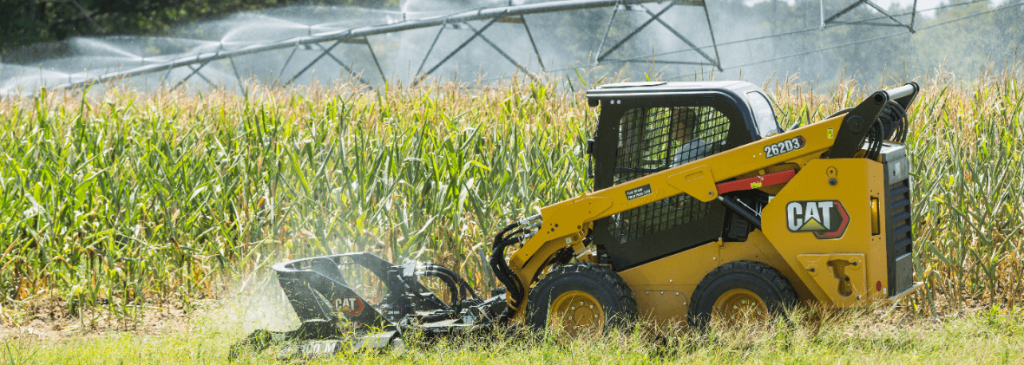
CAT is known for their heavy construction equipment, but they have excellent skid steers as well. They are considered to have great service and their equipment is reliable.
Gehl
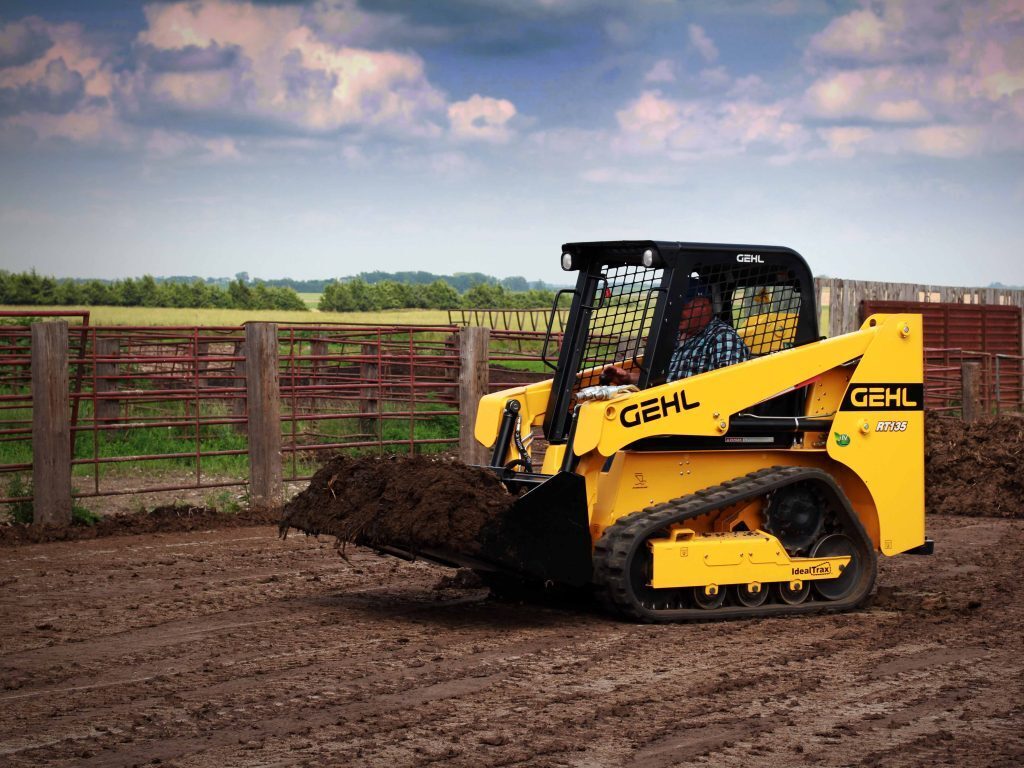
Gehl has been a long standing company in the agriculture market. They have high quality skid steers for both farming and construction purposes. Their machines range from very compact, used for navigating small spaces, to large skid steers that have impressive lifting capacity.
They also have an excellent selection of both “Radial lift” and “Vertical lift” skid steers. (We will get into that in much more detail later)
John Deere

John Deere is obviously a well-known name in the agriculture industry as well, but they manufacture more than just tractors. They have a great selection of large sized skid steers. Their equipment is well built and reliable.
Case

Case currently has the largest compact track loader on the market, with an operating weight of 16,100 pounds. Although you wouldn’t want this machine for work done in small spaces, it has an extremely high 114 horsepower, so it can accomplish some tough tasks.
JCB

A lesser known brand that still produces great machines is JCB. They have a wide variety of equipment, skid steers being one of them. They are similar to other brands that were developed for construction purposes and are quite rugged.
When looking to purchase a skid steer, you may want to research a variety of brands, and determine which one meets your needs the best. (We will discuss more things to consider when buying in a later portion of this article.)
Skid Steer Attachments
Part of what makes skid steers so useful is the different attachments you can choose from.
The reason attachments work so well is the strong hydraulic system. Hydraulics create the power that is needed to operate the attachments.
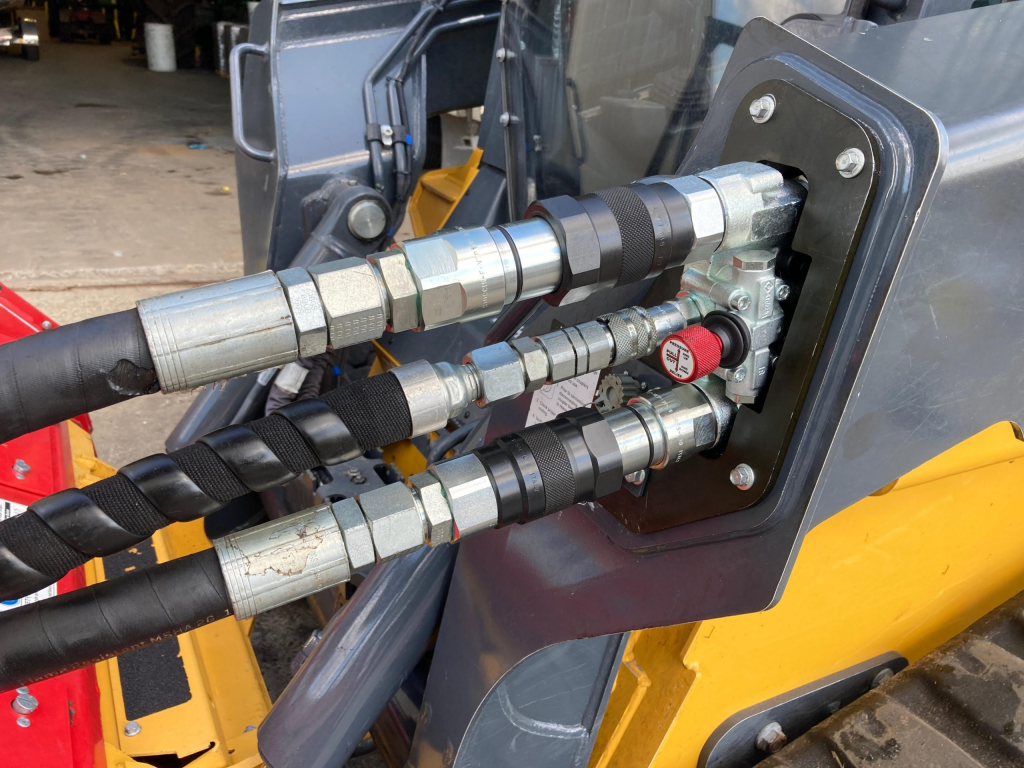
Skid steer attachments work like this:
- The attachment is connected to the machine by a quick-attach system (generally). This allows you to attach buckets and forks instantly.
- Next, the hydraulics need to be attached if the attachment uses hydraulics. Hydraulic hoses attach to the skid steer’s hydraulic ports, which then transfers hydraulic fluid to the attachment and allows it to operate.
- Then, the operator is able to control the attachment from within the cab using the joysticks and controls.
- If the attachment calls for more or less power the operator is able to control hydraulic flow from within the cab.
What attachments can I get?
So now that we know how attachments work, what attachments are there? There are so many available it might be easier to answer the question “What attachments AREN’T there?”
There are attachments designed to lift, dump, pick, shovel, crush, spray, pound, trench, carry, load, and grab. Essentially, there is an attachment for every job you could ever do. In this article, we will focus on the most important attachments.
Buckets
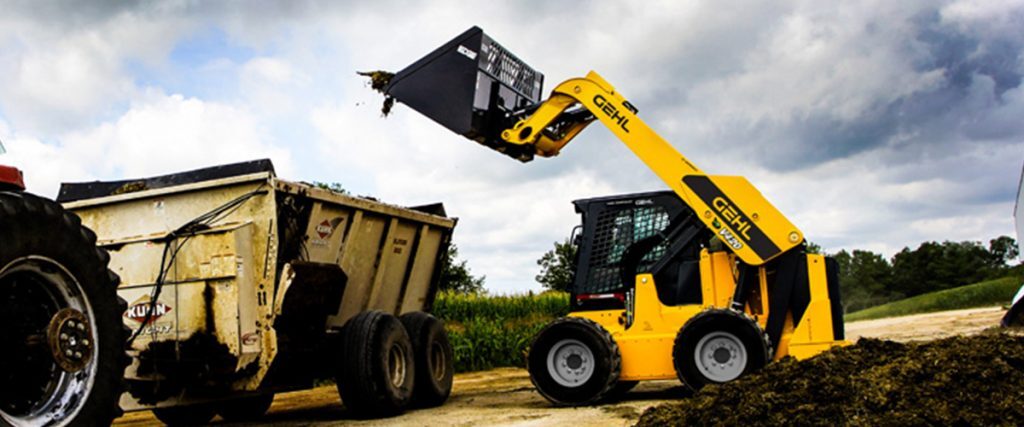
Bucket attachments are used for a lot of different jobs. It is the most common skid steer attachment, and can accomplish a lot of tasks that have specially designed attachments as well. They can dig, push, lift and transport dirt and debris.
Some bucket attachments are designed to be more useful, such as low profile buckets, multipurpose buckets like the 4-in-1 bucket, and manure buckets.
Forks
These are used for lifting pallets, logs, rebar, 2×4, and anything long or that can be stacked onto them well.
Augers
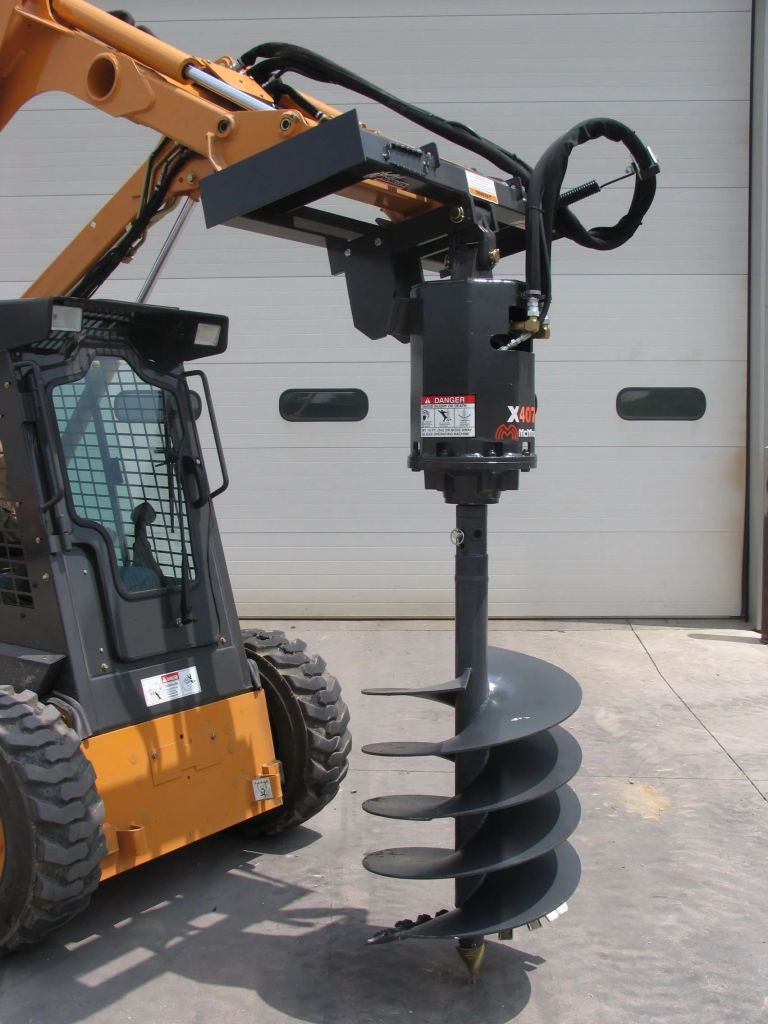
Augers dig holes and trenches. They can be used to quickly excavate fence post holes that are the perfect size, or to plant trees.
Grapple Attachments

Grapples are claws that can open and close over debris or materials, and move them from one place to another. There are a variety of grapples such as root grapples and rock grapples.
Hydraulic Hammers

These can be used for several jobs, such as jackhammering concrete, or pounding fence posts.
Trencher

Designed for digging trenches for utilities like water, gas, and electrical lines.
Landscaping Attachments

There are a lot of landscaping specific attachments for skid steers, as this is one of their most common applications. Rotary tillers are used for dense soil that is filled with rocks and roots. Stump grinders can eliminate stumps and heavy shrubbery. There are land-leveling attachments, but most people simply use the bucket attachment.
Snow Removal Attachments

Snow plows and snow blowers are very useful attachments. They are used often on construction sites for snow removal. They also work well for clearing heavy snow on sidewalks.
You can also use snow blowers, plows, and even a broom attachment to remove snow from roads, driveways, and parking lots.
Brush Cutters
These work exceptionally well for clearing and developing land.
Concrete Mixer
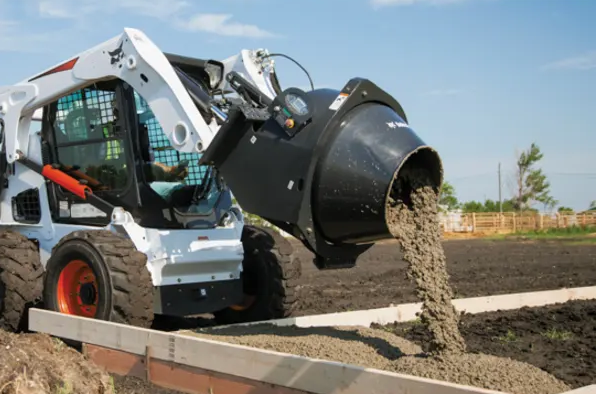
Yes, there is even a concrete mixer attachment. For contractors who have a skid steer, but can’t justify the purchase of a full sized cement mixer, a smaller cement mixer attachment works great.
These are just a few of the attachments that make skid steers so amazing. There are a number of other attachments that will likely meet any need you might have.
The important thing to keep in mind is “What do I need to use this for?” and then purchase the necessary attachments.
Skid Steer Prices
You’re probably wondering what a machine like this normally costs. It’s a great question, and the answer varies from brand, dealership, area of purchase, and the specs and age of the skid steer.
These variables are important, so we will try to subdivide our categories a little bit. (If these prices seem a little unreasonable, we will also discuss some things that can save you money, as well as used and rental options.)
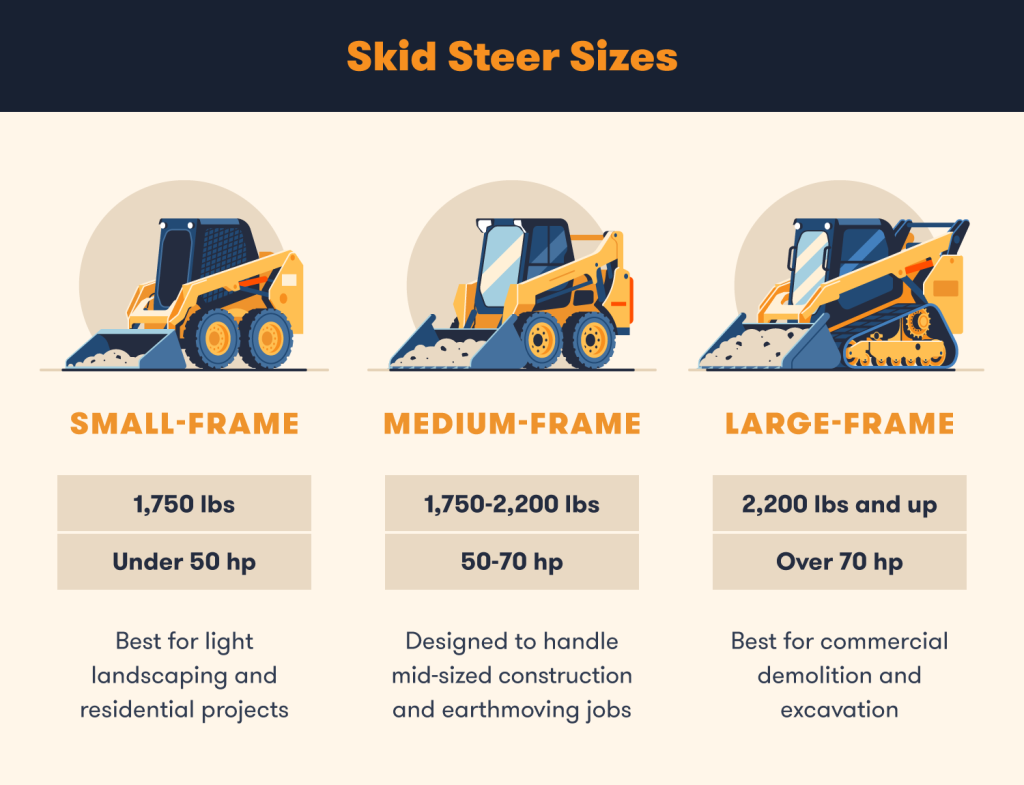
Mini Skid Steer
Mini skid steers are the most compact. They tend to be used for lighter work that requires the ability to navigate in small places. The price for a new mini skid steer can range from $25,000 to $35,000 based on the brand and purchase area.
Compact and Medium Sized
Mid-sized skid steers are used for general agriculture and construction purposes. They can range from $40,000 to $80,000 brand new.
Large Skid Steers
These are not used as often, as they are no longer very compact. However, the power they provide is pivotal for some jobs. They can range in price from $60,000 to $100,000+ based on how large it is and the brand.
Total Cost of Ownership
An important thing to remember about buying a skid steer is that the sticker price is only part of the story. Total cost of ownership represents the original cost of the machine, repairs necessary, warranty, fuel, and more.
You should use a Total Cost of Ownership calculator to show you your total investment based on how many hours you use it for. Gehl has a very useful TCO calculator.
These shouldn’t be taken as exact numbers, but they are accurate and helpful.
What about buying a used skid steer?

If you determine that the TCO will be higher than you would like to spend, then you can consider buying a used machine.
Skid steers are rugged, and can last for many hours of work. By buying a used skid steer, you can save yourself thousands of dollars, and still get a reliable machine.
Companies like Tractor Zoom (Find Farm Equipment Near You | Tractor Zoom) allows you to see both used and new equipment and get a price range for what is available, and how they compare.
Additional Costs
Attachments
Because attachments provide so much value to skid steers, it is important to know how much they cost as well. Some smaller attachments, such as buckets and forks, can be purchased for a few hundred dollars. Heavy duty attachments that rely on hydraulic power, are much more expensive, and can cost thousands of dollars.
Additional Features
Additional features can also increase the cost. Be aware of what features you can get when buying a skid steer.
Warranty
You shouldn’t consider a warranty an extra expense, as a good warranty is actually an investment. Take time to determine what type of warranty you will want, and find the manufacturer who will offer it.
Things to consider when buying a skid steer

Here are a few important things to consider when buying:
- How much lifting capacity do I need?– Higher lift capacity means a more expensive machine. Only purchase the amount you will need.
- Will I use it on hard surfaces or soft surfaces?– By answering this question, you will know whether or not you should get a wheeled or track machine.
- Will I need greater lift height?– Vertical lift skid steers will be better for lifting things upward. Determine what the maximum lifting height is of the machine you are interested in, and be sure it reaches high enough.
- Does this brand include a good warranty?– Warranty is so important with heavy machinery. Make sure the brand you purchase from has a suitable warranty and extensions available.
- Could I rent instead?– Skid steer rental is a good way to accomplish a tough job without breaking the bank. If you only need it for occasional use, it may be more useful to rent than to buy.
Conclusion

Hopefully, this article has helped you answer your questions about skid steers, whether you are trying to learn more about them, or looking to make a purchase.
Whatever task you are trying to complete, skid steers are dependable, adaptable, and can accomplish things that might otherwise take multiple machines.
Maple Lane Skid Steers
If you are interested in purchasing a skid steer, and you’re in the southern Ontario region, give us a call! We have both new and used options from Gehl and Manitou.

